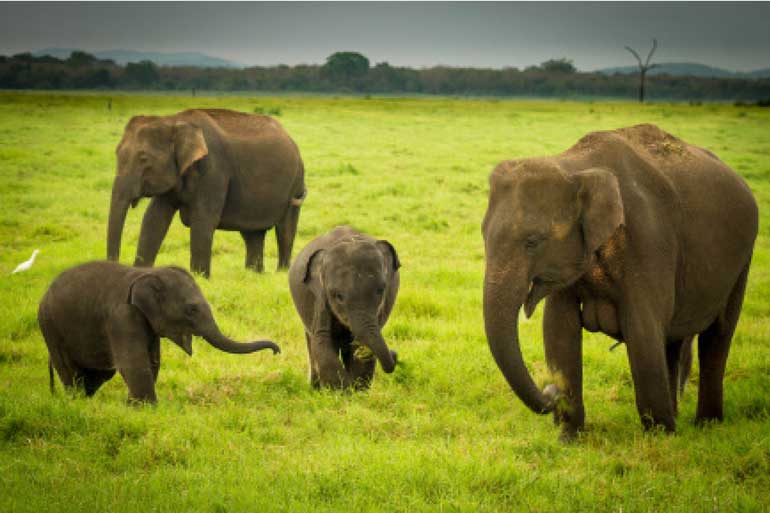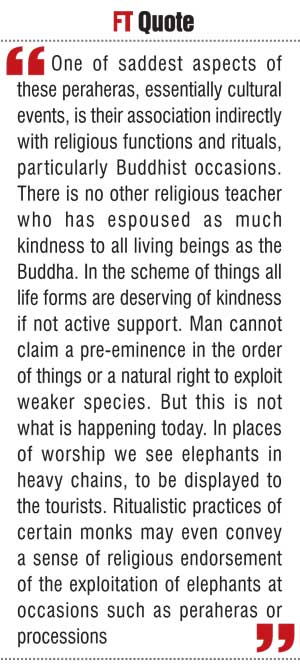Sunday Dec 21, 2025
Sunday Dec 21, 2025
Thursday, 12 November 2015 00:00 - - {{hitsCtrl.values.hits}}

It is said that we have about 5,000 elephants in the wild today. Their fate, bad as it is with fast-receding jungles and often fatal conflict with humans, is still much preferable to the fate of their brothers in human captivity. For the mighty elephants, born to be free, captivity is a story of miserable bondage
Recently I received an electronic link on the plight of Sri Lankan elephants, particularly those captured, tamed and put to work in various ways. The main theme of the widely circulated YouTube clip was man’s cruelty to this magnificent beast that happens to share this land with us. It was a shameful indictment of the country, of a people unable to appreciate a precious gift of nature.
It is said that we have about 5,000 elephants in the wild today. Their fate, bad as it is with fast-receding jungles and often fatal conflict with humans, is still much preferable to the fate of their brothers in human captivity. For the mighty elephants, born to be free, captivity is a story of miserable bondage.
If the argument is based on who got here first, then of course the elephants win by several centuries. They pre-date the Homo sapiens whose migration to these parts was later. This was their land before we claimed it. For a long time the two species co-existed with little conflict. We were only hunter gatherers then. Later, when humans evolved and began to use draft animals the elephant became a prize possession.
Eventually they began to be used in ceremonial/cultural ways, becoming a symbol of power, pomp and majesty, evidently qualities much valued, especially when given the realities of a small and troubled country the prevalence of true power or genuine majesty is doubtful. The attempt at the display of power and majesty in such primitive ways only undermines the idea, conveying the very opposite, a people with no power, mediocre, superficial and fickle.
Meaningless exploitation
Even though modern man’s access to machinery and engines has made the exploitation of animals of burden meaningless, time-consuming and even expensive, it still is very prevalent in the country. Overloaded bullock carts are a common sight on rural roads. After pulling the heavy burden for a few years, the unfortunate bull is inevitably sold to a butcher.
In the old days the heaviest tasks were of course reserved for the elephant. Most of the constructions of the past were made possible only by the pulling power of these majestic beasts. Fortunately for the elephant, today’s construction industry has outstripped the need for elephant power. In the cities they are not a factor in that sector anymore. But that does not mean that the elephants are now released from their burdens. Other and even more damaging tortures have been thought up by their human masters.
Showpiece for tourists
In the important tourist industry elephants have become a showpiece. If it is just that, knowing the importance of the tourist dollars, we cannot raise serious objections. But practices such as elephant rides are surely objectionable. In some hotels the elephants work long hours carrying its human cargo.
Needless to say everything in this form of activity is designed only with humans and dollars in mind. No consideration whatsoever is given to the wellbeing of the animal. For instance, the seat placed on the elephants back is extremely heavy. They invariably result in injury to the elephant’s skin and perhaps even permanent damage to its back. No living species will willingly carry such a burden, from sunrise to sunset, seven days of the week. But that is often the plight of the elephants put to work in tourist centres.

Crude and rough treatment
Even in the so-called elephant sanctuaries the handling of the elephants is crude and rough. There is no indication of consideration or kindness for the captured animal. With metal prods the elephants are urged on in shrill tones by their mahouts most of who appear to interpret their task in the crudest terms.
It is impossible to conceive of any concern on their part for the elephant’s welfare, leave alone animal psychology. The whole thing is managed only by the use of heavy chains on the poor animal’s feet and merciless use of whips and metal prods. Almost all captured elephants have festering wounds on their feet, caused by the heavy chains.
Peraheras
A most damnable use of the elephant in this society is at the peraheras or processions. While the occasional use of elephants in such pageants with due consideration for the animal may be overlooked, the manner in which they are used in some of the peraheras cannot be forgiven.
For an animal meant to roam the jungle tracks freely, there surely cannot be something more traumatic than to be chained and prodded painfully in the midst of a frenetic throng, the deafening noise from drums and other instruments, endless crackle of the loudspeakers and the fiercely burning torches. That such brutal torture of a captured animal passes off for a cultural activity among a people is telling of their basic instincts.
Sense of religious endorsement
One of saddest aspects of these peraheras, essentially cultural events, is their association indirectly with religious functions and rituals, particularly Buddhist occasions. There is no other religious teacher who has espoused as much kindness to all living beings as the Buddha. In the scheme of things all life forms are deserving of kindness if not active support. Man cannot claim a pre-eminence in the order of things or a natural right to exploit weaker species.
But this is not what is happening today. In places of worship we see elephants in heavy chains, to be displayed to the tourists. Ritualistic practices of certain monks may even convey a sense of religious endorsement of the exploitation of elephants at occasions such as peraheras or processions.
This has now become so pervasive that an uninitiated visitor may be excused for assuming that the elephant has a special place in Buddhist teachings. But Buddhism is not meant only for countries where elephants are to be found. The dismal following of the doctrine in this island are giving this sublime philosophy a reputation totally undeserved.
They do this at their peril. For it is said that the elephant is a noble creature with a long memory.